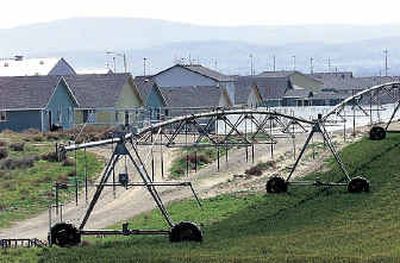Study reports West to have growth spurt

BOISE – There’s little to stand in the way of the population boom projected for the West over the next 25 years, researchers say.
“We geographers have a long history of thinking very seriously of the ability of environmental limits to put the brakes on human development,” says William Travis of the Center of the American West at the University of Colorado. “I just don’t see it. Especially in the West.”
Never mind a legacy of hand-wringing over the lack of water beyond the 100th meridian, the longitude that bisects the country, separating the moist Eastern United States from the drier West.
Three of the most arid states in the nation – Arizona, Utah and Nevada – are forecast by the U.S. Census Bureau to be among America’s fastest-growing on a percentage basis through 2030.
“You look at annual rainfall, and you ask, ‘How can a Phoenix exist?’ ” says demographer Robert Lang, director of the Metropolitan Institute at Virginia Tech University in Alexandria, Va., and author of “Edgeless Cities.”
“But the West has a willingness to talk about sustainability and can adapt,” he says. “I think the region is poised for serious growth.”
Warm climates, low housing prices, growing job markets, accelerated immigration, expanded Internet availability, improved transportation and the lure of wide-open scenic vistas are among the major factors demographers say will contribute to the West’s sprawling growth.
Six of the top 10 states forecast to have the fastest-growing populations on a percentage basis through 2030 are in the West.
Lang uses presidential electoral vote clout to illustrate what the West will become if the projections hold true.
“When they say now how you’ve got to win Ohio and Michigan, by then you’ll have to win Arizona, too,” he says. “Nevada will be a Connecticut and even a smaller state like Idaho starts closing in on Kansas.”
Mike Ferguson, chief economist for Idaho Gov. Dirk Kempthorne, remembers the decade of the 1980s when the state struggled just to stay above 1 million residents.
“The joke was we ought to celebrate every time we passed a million, going in either direction,” he says.
“Some factors may kick in that have to do with carrying capacity relating to certain kinds of businesses, but as far as the ability of the state to have the kind of population growth they are projecting, I just don’t see anything that will stop it.”
But beyond the carrying capacity of the landscape’s ability to handle the influx of newcomers, Travis says there is a realization of the social and environmental degradation that urbanization brings.
Put another way: That which attracted us, we now cause its demise.
“People are coming here for the quality of life and the open spaces,” says Michael Clark, director of the Western Water Project for Trout Unlimited. “How do we keep that and how do we change? It may be one of the most vexing questions facing the society of the West.”